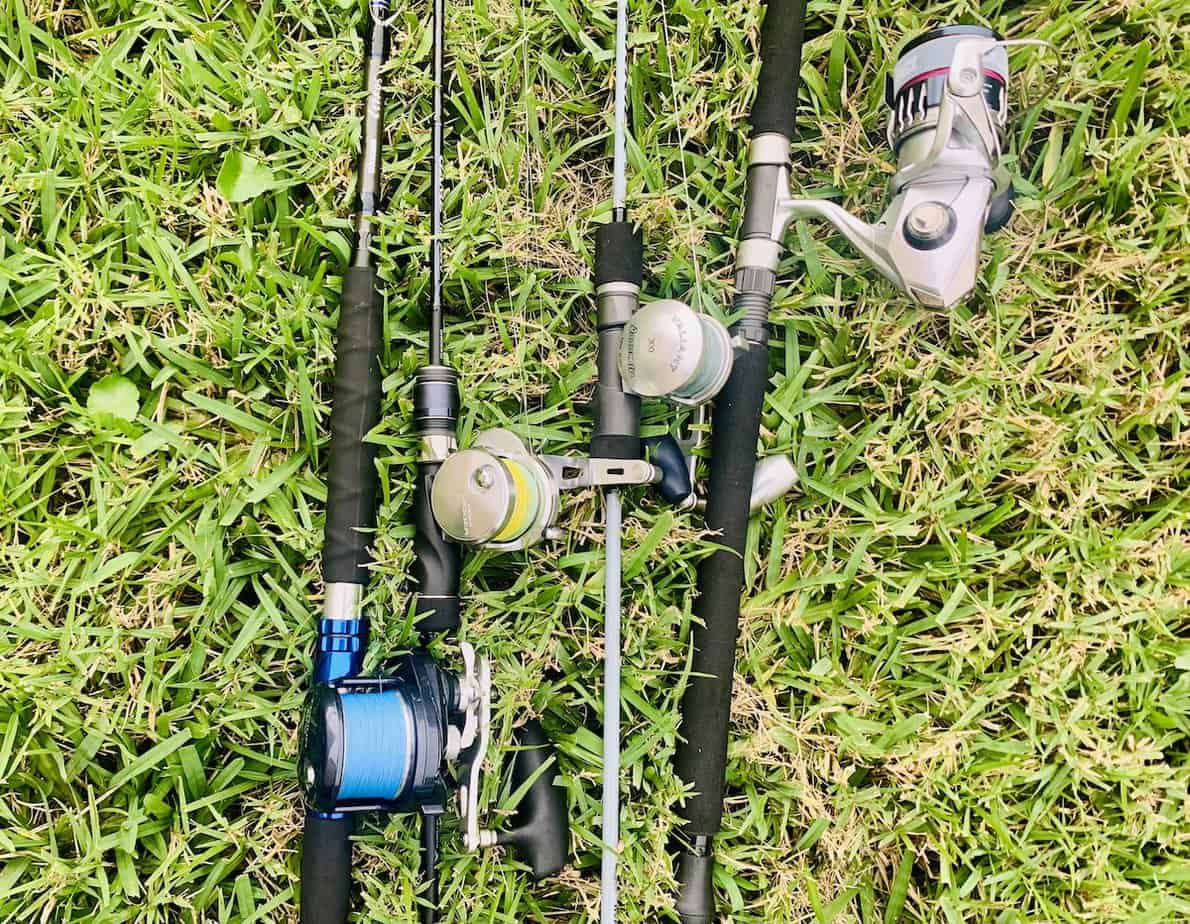In this article, I’ll discuss the various features of the best jigging reels at different price points. There are slow pitch jigging reels, and speed jigging reels. Slow pitch jigging reels are all conventional reels because of the need to control the rate of freespool with thumb pressure on the spool. Speed jigging can be done well with either a spinning reel or conventional reel, whichever the angler prefers.
The tables throughout this article will break the best reels up into 3 main categories: (1) conventional reels for slow pitch jigging, (2) spinning reels for speed jigging, and (3) conventional jigging reels for speed jigging. The product links in this article will take you to the product page on Tackle Direct's website.
| Reel | Speed/Slow | Spin/Conv | |
| 1 | Accurate Boss Valiant SPJ | Slow Pitch | Conv |
| 2 | Shimano Ocea Jigger | Slow Pitch | Conv |
| 3 | Daiwa Saltiga Lever Drag | Slow Pitch | Conv |
| 4 | Shimano Saragosa SW | Speed | Spin |
| 5 | Penn Authority | Speed | Spin |
| 6 | Shimano Stella SW C | Speed | Spin |
| 7 | Shimano Torium PG | Speed | Conv |
| 8 | Avet JX 6/3 MC Raptor | Speed | Conv |
Spinning or Conventional
When it comes to slow pitch jigging, the best slow pitch jigging reels are all conventional style reels. This is for several reasons. When considering how a slow pitch jigging technique is performed, the angler holds the rod and reel and the jig falls to the ocean floor in freespool. When using a conventional reel, the angler palms the compact reel and applies thumb pressure on the spool to control the rate of freespool. When using a spinning reel, there is no way for the angler to decrease or increase the rate of freespool. This prevents the angler from making adjustments to catch fish.
High speed vertical jigging is different in that it can be done well with either a spinning reel or conventional reel. Spinning reels are much easier for fishermen to learn to use, which is especially important in a technique such as high speed vertical jigging when there’s a lot going on at once. In this technique, anglers are working the rod in a twitch and pause pattern while simultaneously winding the handle as fast as he or she can.
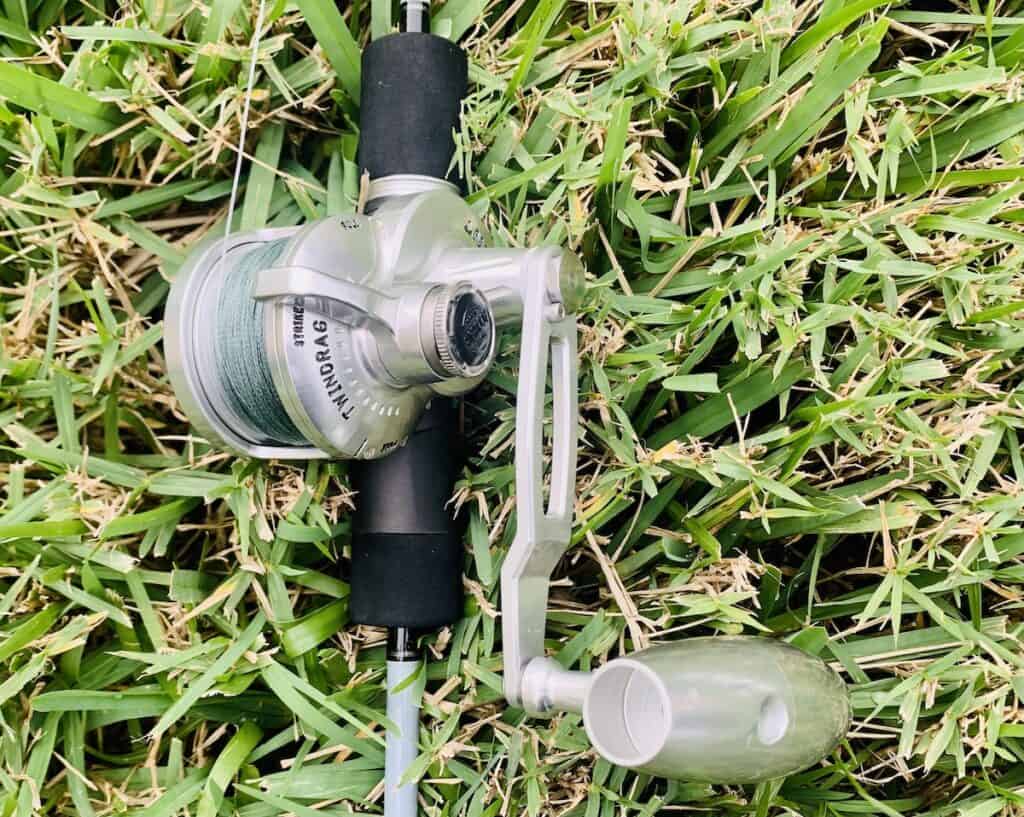
Some anglers find that it’s easier to control the rod and reel with a small conventional reel, and some find that a spinning reel is better because it’s nearly impossible to mess it up. Whichever your preference, this article will cover reels in that category.
Reel Weight and Braid Capacity
Slow pitch jigging is much easier when using a lightweight reel. The fisherman will be palming a narrow and compact reel and slowly and rhythmically working the rod up and down. This is a slow technique, so it does not tend to tire out fishermen. Anglers will perform this technique for hours on end. A lightweight reel can go a long way in helping a fisherman keep going.
The weight of a high speed jigging reel is also important, albeit not to the same extreme. Speed jigging is a shorter term technique, so the weight does not need to be quite so light. In speed jigging, the reels are designed to favor strength over weight because of the powerful strikes and higher line strength used.
Braid is the best main line to use for jigging because of its small diameter. The small diameter helps the angler maintain control of the jig even as it gets into deep water. Slow pitch and speed jigging require the angler to feel when the jig hits structure or bottom, and you must decrease the scoping of the line in order to do this. Braid also does the best job at transmitting that feeling from the jig to the reel, reel seat, and ultimately to the angler. To read more detail about the best main line for jigging, I invite you to read my article Is Braid or Mono Best for Jigging?
The reason I mention the type of main line for jigging is because it greatly affects the line capacity specs on the reels. You’ll frequently see line capacity specs listed for monofilament and braided line. The line capacity is always less for monofilament of the same line strength because of the larger diameter of monofilament. For jigging, maximizing the line capacity on your reel is key because you’ll be dropping the jigs all the way down to the ocean floor and then fighting strong fish.
On top of the braid or monofilament choice, you’ll need to have an idea of what line strength you plan to use. For slow pitch jigging, 30 lb test is the norm. Some anglers will go even lighter in deeper water to improve how the line cuts through the water. For speed jigging, the line strength is higher and tends to be between 40 lbs and 65 lbs. Some anglers will go higher when targeting large tuna.
The amount of line you really need must also be considered for you to choose the best reel for you. I always share my method of estimating your line capacity needs. I advise people to look at a TopSpot map for the area(s) that they most often fish. Look at the water depth in the areas you’ll usually fish. For me, I fish off the East coast of central Florida, within about 15-20 miles of shore where the depths stay under 250 feet for the most part. You’ll need a little margin on top of that number to account for fighting fish and variation in the way the reel is spooled (all the way to the max or room for a leader).
Make sure you consider the units. The TopSpot map depths are listed in Fathoms and usually the line capacity specs are listed in Yards. To convert between Fathoms and Yards, multiply the fathoms by 2. The table below shows the braided line capacity and weight of the top 8 jigging reels.
| Reel | Speed/Slow | Model | Braid Capacity | Weight | |
| 1 | Accurate Boss Valiant SPJ | Slow Pitch | BV-300-SPJ | 30/325 yds | 9.9oz |
| 2 | Shimano Ocea Jigger | Slow Pitch | OCEAJG1500HG | 40/300 yds | 14.3oz |
| 3 | Daiwa Saltiga Lever Drag | Slow Pitch | SAGLD35JH | 30/440 yds | 20.8oz |
| 4 | Shimano Saragosa SW | Speed | SRG8000SWAHG | 40/340 yds | 23.8 oz |
| 5 | Penn Authority | Speed | ATH8500 | 40/730 yds | 31.1oz |
| 6 | Shimano Stella SW C | Speed | STLSW8000PGC | 40/340 yds | 22 oz |
| 7 | Shimano Torium PG | Speed | TOR20PGA | 50/710 yds | 19.8oz |
| 8 | Avet JX 6/3 MC Raptor | Speed | JX 6/3 MC Raptor | 65/560 yds | 24oz |
Max Drag and Drag Style
At times I’ve noticed anglers over-prioritize the max drag specs. Your drag setting should always be about 25-30% of the breaking strength of the line. As we learned in the last section, the norm for slow pitch jigging is to use 30 lb test braid. This means your drag will usually be set at about 10 lbs. All of the slow pitch reels listed here can reach 10 lbs of drag. The lowest one is the Shimano Ocea Jigger. In all reels, but especially this one, you’ll need to properly maintain the reel to prevent the drag from degrading to a point that’s under what you need. To do this, the drag on the reel should be in freespool when you store it.
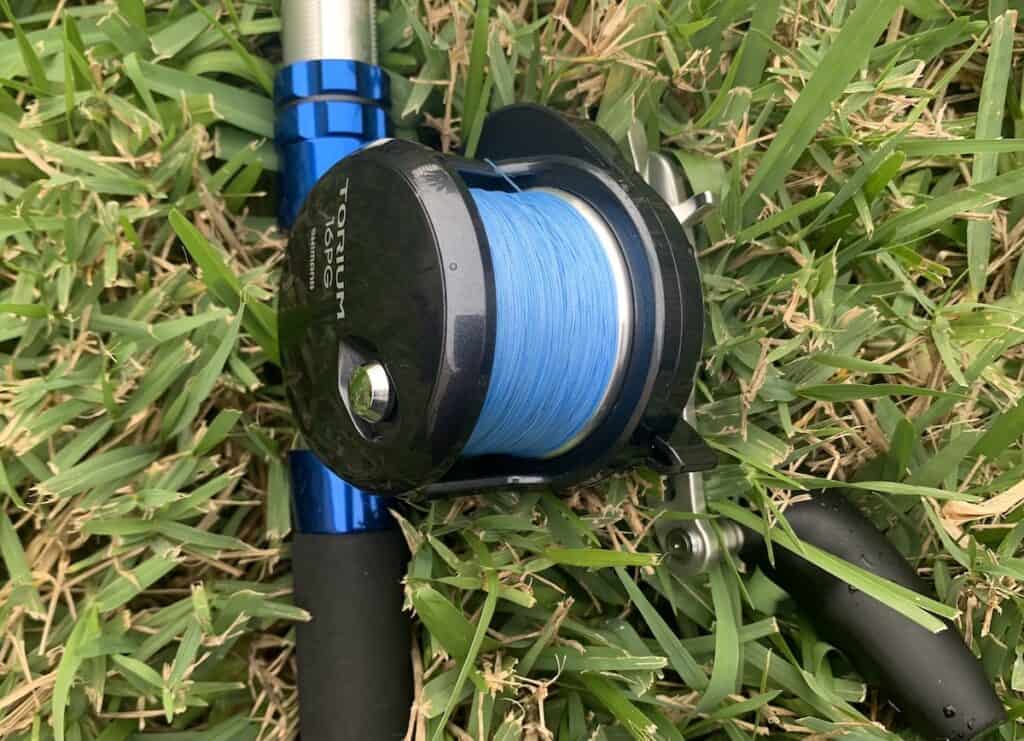
The line strength for speed jigging is higher. Generally it’s between 40 or 65 lb. When using 65 lb line, the drag will likely be set at nearly 20 lbs. All of the speed jigging reels listed in the table below can easily accomodate 20 lb drag. When using a lever drag reel, the 25-30% drag setting should be set at the strike location.
| Reel | Speed/Slow | Spin/Conv | Model | Max Drag | Drag Style | |
| 1 | Accurate Boss Valiant SPJ | Slow Pitch | Conv | BV-300-SPJ | 23 lb | LD |
| 2 | Shimano Ocea Jigger | Slow Pitch | Conv | OCEAJG1500HG | 15 lb | Star |
| 3 | Daiwa Saltiga Lever Drag | Slow Pitch | Conv | SAGLD35JH | 40 lb | LD |
| 4 | Shimano Saragosa SW | Speed | Spin | SRG8000SWAHG | 35 lb | Spin |
| 5 | Penn Authority | Speed | Spin | ATH8500 | 50 lb | Spin |
| 6 | Shimano Stella SW C | Speed | Spin | STLSW8000PGC | 55 lb | Spin |
| 7 | Shimano Torium PG | Speed | Conv | TOR20PGA | 33 lb | Star |
| 8 | Avet JX 6/3 MC Raptor | Speed | Conv | JX 6/3 MC Raptor | strike 28, full 38 | LD |
There are three types of drag systems in fishing reels and they each work effectively. In spinning reels, a stack of drag washers is at the bottom of the reel with an adjustment knob on the top. When the knob is adjusted, the washers are squeezed together against the spool. In conventional reels, you can have either star drag or lever drag.
Star drag systems use a drag washer stack against the drive gear which is connected to the main gear that moves the spool. Lever drag systems have large drag washers directly against the spool with a lever to adjust the pressure. Lever drag systems allow for the drag to be increased from the strike setting to the full setting for extra help landing a fish.
Although each of these drag types works well, some are better for certain applications than others. Star drag tends to be used for lighter, inshore applications because the fish in these areas aren’t quite as strong. Drag washers can get extremely hot when a fish is peeling line off. Star drag has several smaller drag washers with smaller surface area which causes them to stay hot longer. In extreme situations, this can warp and ruin the drag washers. In lever drag systems, the drag washers are larger in surface area and are fairly good at releasing heat. This makes lever drag systems best for targeting big and strong fish offshore.
Gear Ratio and Retrieve Rate
Gear ratio and retrieve rate are related. As gear ratio goes up, so does the retrieve rate, although it also depends greatly on the spool diameter. In slow pitch jigging, a high gear ratio and fast retrieve rate is beneficial. Although it may seem counterintuitive, a fast retrieve rate gives the angler the best control over the amount of slack in the line and helps pull fish up quickly from deep depths.
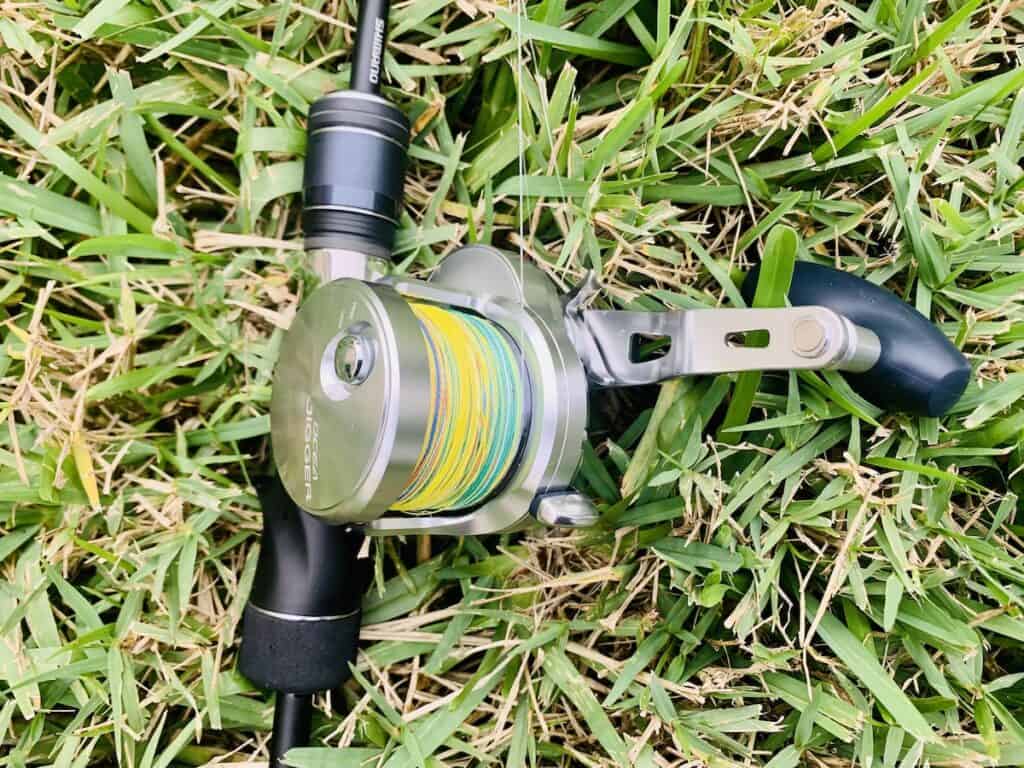
In speed jigging, retrieve rate is not nearly as important as power. Power gears are important in speed jigging to pull strong fish up out of structure. Lower gear ratios have higher power because the larger gear teeth can withstand the force of a grouper thrashing to cut the line. The table below shows the gear ratio and the retrieve rate of the best jigging reels. These reels all have an appropriate gear ratio and retrieve rate for the specified jigging method. To learn more about speed jigging, read my article Speed Jigging: Everything You Need to Know.
| Reel | Speed/Slow | Spin/Conv | Model | Gear Ratio | Retrieve Rate | |
| 1 | Accurate Boss Valiant SPJ | Slow Pitch | Conv | BV-300-SPJ | 6:1 | 38IPT |
| 2 | Shimano Ocea Jigger | Slow Pitch | Conv | OCEAJG1500HG | 6.4:1 | 39IPT |
| 3 | Daiwa Saltiga Lever Drag | Slow Pitch | Conv | SAGLD35JH | 6.3:1 | 47IPT |
| 4 | Shimano Saragosa SW | Speed | Spin | SRG8000SWAHG | 5.6:1 | 42IPT |
| 5 | Penn Authority | Speed | Spin | ATH8500 | 4.7:1 | 42IPT |
| 6 | Shimano Stella SW C | Speed | Spin | STLSW8000PGC | 4.9:1 | 37IPT |
| 7 | Shimano Torium PG | Speed | Conv | TOR20PGA | 4.6:1 | 34IPT |
| 8 | Avet JX 6/3 MC Raptor | Speed | Conv | JX 6/3 MC Raptor | 6:1/3.8:1 | 46/22IPT |
Bearing Counts and Style
All too often I see anglers compare reels based on the number of bearings. Let me say that 4 bearings placed in the correct places is “enough” bearings. Don’t be fooled into thinking that a high number of bearings is the only way to get a smooth feeling reel. You must realize that bushings can perform just as well as bearings in certain places such as the handles.
As an example, consider the Penn Authority spinning reel. It is undoubtedly a great reel. Penn has put a whopping 13+1 bearings in the reel. Two of them are simply in the handle where plenty of other reels use bushings.
The table below contains bearing counts and also includes the bearing style. It’s very common for saltwater reels to have anti-rust, or corrosion resistant, ball bearings. The next level up of bearing quality includes shields that covers the races to keep salt, water, and other debris out. This is very important for a reel’s longevity in a saltwater environment. An unprotected ball bearing will start to feel gritty after repeated exposure to salt water.
| Reel | Speed/Slow | Spin/Conv | Model | Bearing Count | Bearing style | |
| 1 | Accurate Boss Valiant SPJ | Slow Pitch | Conv | BV-300-SPJ | 7+1 | 2 sealed ARB |
| 2 | Shimano Ocea Jigger | Slow Pitch | Conv | OCEAJG1500HG | 8+1 | S-ARB |
| 3 | Daiwa Saltiga Lever Drag | Slow Pitch | Conv | SAGLD35JH | 6+1 | CRBB |
| 4 | Shimano Saragosa SW | Speed | Spin | SRG8000SWAHG | 5+1 | S-ARB |
| 5 | Penn Authority | Speed | Spin | ATH8500 | 12+1 | SS, 1 shielded |
| 6 | Shimano Stella SW C | Speed | Spin | STLSW8000PGC | 13+1 | S-ARB |
| 7 | Shimano Torium PG | Speed | Conv | TOR20PGA | 3+1 | S-ARB |
| 8 | Avet JX 6/3 MC Raptor | Speed | Conv | JX 6/3 MC Raptor | 8 | sealed SS |
Daiwa’s CRBB bearings are shielded corrosion resistant ball bearings, Shimano’s S-ARB bearings are shield anti-rust ball bearings. The “+1” bearing refers to the anti-reverse bearing.
Body Material and Price
Another consideration is the reel body material. With speed jigging, since it is a heavy tackle technique used to target strong fish, the reel body should be very rigid and strong. If the reel is allowed to flex, it makes it harder to put leverage on the fish and can also cause damage to the reel body.
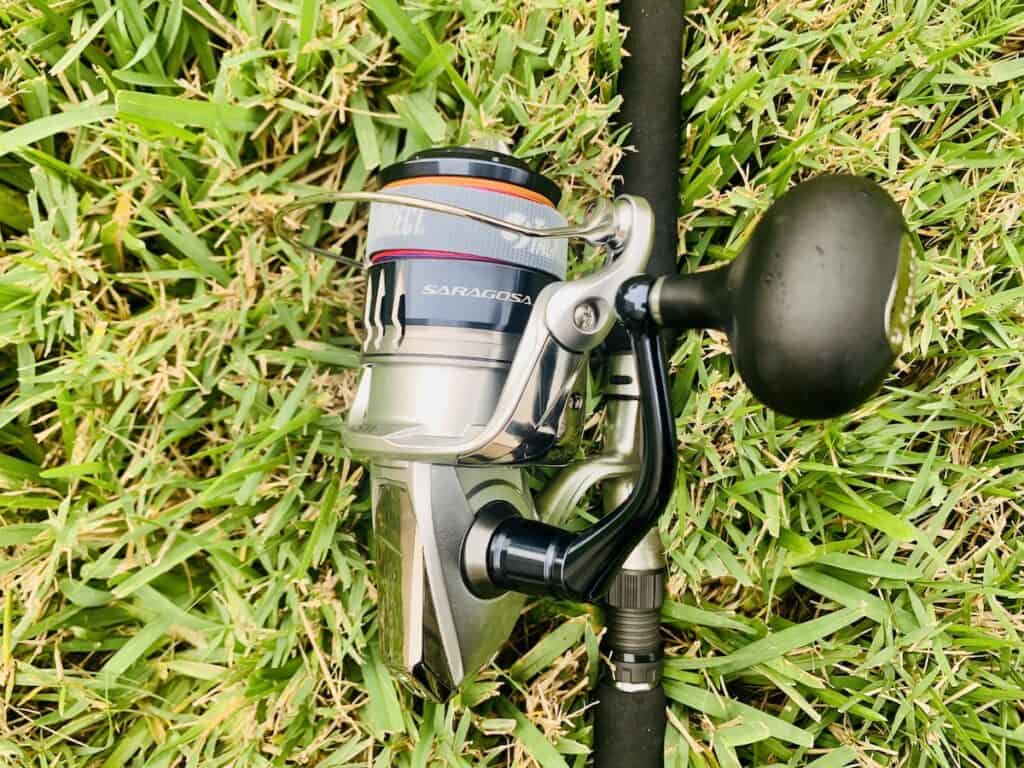
Most reels use an anodized aluminum body. Shimano developed a proprietary metal body with high rigidity and is called the Hagane body. Unless you’re looking at a very low cost reel, chances are the reel body is a sufficient strength for 99% of the fishing most anglers do.
The table below shows the body material and the price of the 8 reels we’ve been looking at in this article. I included a variety of prices in each of the 3 categories, (1) conventional reels for slow pitch jigging, (2) spinning reels for speed jigging, and (3) conventional jigging reels for speed jigging. In general, the higher the price, the better quality the reel is. The most expensive reels will usually edge out the competition by being lighter in weight, higher line capacity, more compact body, better quality bearings, and better drag washer materials.
| Reel | Speed/Slow | Spin/Conv | Model | Body material | Price | |
| 1 | Accurate Boss Valiant SPJ | Slow Pitch | Conv | BV-300-SPJ | aluminum | $480 |
| 2 | Shimano Ocea Jigger | Slow Pitch | Conv | OCEAJG1500HG | Hagane | $520 |
| 3 | Daiwa Saltiga Lever Drag | Slow Pitch | Conv | SAGLD35JH | aluminum | $580 |
| 4 | Shimano Saragosa SW | Speed | Spin | SRG8000SWAHG | Hagane | $270 |
| 5 | Penn Authority | Speed | Spin | ATH8500 | full metal body | $570 |
| 6 | Shimano Stella SW C | Speed | Spin | STLSW8000PGC | Hagane | $1,050 |
| 7 | Shimano Torium PG | Speed | Conv | TOR20PGA | Hagane | $250 |
| 8 | Avet JX 6/3 MC Raptor | Speed | Conv | JX 6/3 MC Raptor | aluminum | $484 |
Now that you’ve learned about the different features and how they affect jigging reels, you can choose your reel based on your jigging technique, personal priorities and budget. I wrote another article specifically dedicated to Slow Pitch Jigging Reels that you can check out here. Tight lines, y’all!

